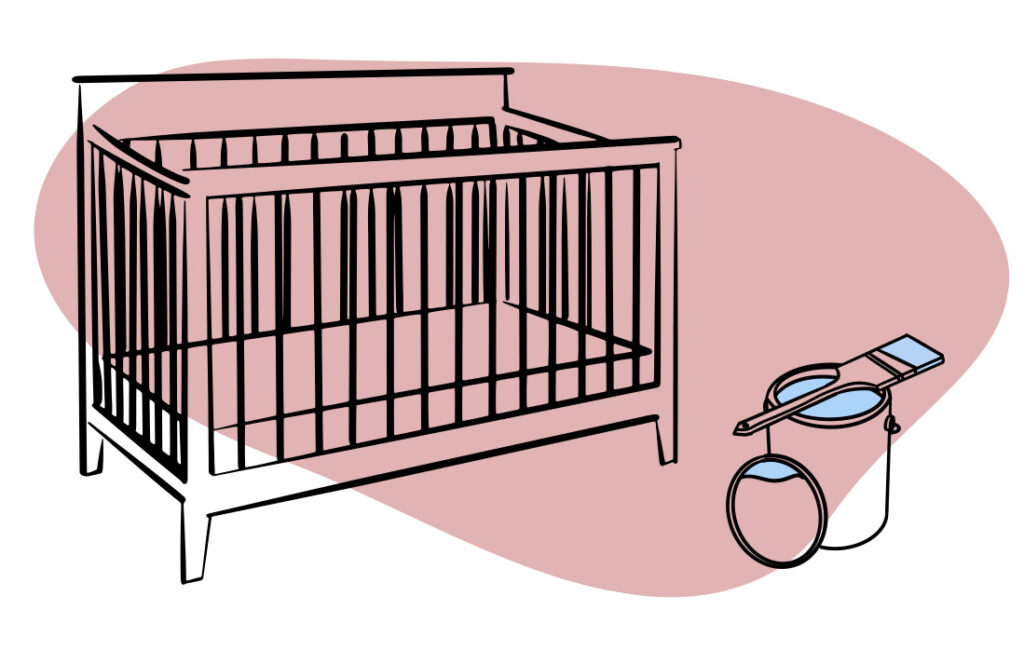The 5 Best Bedroom Colors For Sleep (And The Worst)
Disclosure: By clicking on the product links in this article, Mattress Nerd may receive a commission fee at no cost to you, the reader. Read full disclosure statement.
The color of your bedroom walls can have an impact on your sleep duration and sleep quality. Generally, muted colors like blue, green, or soft white are calming colors for a bedroom.
On the other hand, bright or dark colors—such as red, deep purple, brown, yellow, or black—may lead to poor quality sleep.
Here’s a detailed guide to the best and worst bedroom colors for sleep. We also have tips on what color to paint your child’s bedroom or nursery.
Does Color Affect Sleep?
The color of your bedroom walls can play a big part in your ability to get a good night’s sleep. This is because colors can have a direct effect on mood. The right color can soothe the mind, relax the body, and help ease you into sleep. But the wrong color could keep you awake, increase the likelihood of vivid dreams or nightmares, and reduce overall sleep quality.

Best Bedroom Colors For Sleep
The five best bedroom colors for sleep are:
- blue
- pale pink
- green
- white
- beige
Here’s an in-depth look on why these bedroom paint colors are the best for sleep.
Blue
Blue is generally considered the best color for sleep. According to a 2018 study, blue walls have a calming effect on the brain. There’s also anecdotal evidence that suggests vibrant blues can promote clear thoughts and inspire thoughtful reflection. Additionally, blue is often associated with feelings of stability, trust, and peace.
Pale Pink
OK, so pink may not be for everyone. But when done correctly, light or muted pink can foster feelings of relaxation and tenderness. It can also calm the mind and may increase positivity.
“Flesh toned pinks, like rose blush, are perfect for creating a relaxing bedroom, as the light hues calm the mind, helping you peacefully drift off to sleep,” says Yvonne Kea, Senior Product Manager at Hillarys.
Additionally, according to a 2011 study, being in a pink room may help lower blood pressure and pulse rate. However, more research is needed to really understand the full effects.
Green
Like blue, green can have a calming effect on the mind. It’s also very peaceful since it’s associated with trees, grass, and plants. Also, according to interior designer Tina Martindelcampo, green helps promote sleep by “preventing emotional digressions.”
“Green paint colors are beneficial if you want to create a calm and pleasant environment in your bedroom for sleeping,” she says.
Just keep in mind not all greens work the same. Some shades encourage better sleep than others.
“For better sleep, your green color should have tones of blue, as it will ease you into unwinding yourself when you enter the room,” says David Clark, CEO and Home Improvement Expert at Basement Guides. “It reduces stress and stimulates tranquility for a peaceful sleep.”
White
The lightest color on the spectrum, white can promote feelings of serenity, comfort, and hope. It can also help minimize distraction and help you ease into a relaxed state before sleep. As an added bonus, white ceilings can make your room feel more spacious.
FYI: You might be better off with a creamy, off-white color as opposed to a stark white. A bright white bedroom might put you in a state of high-alert, leaving you restless.
Beige
Beige walls offer a neutral, calm, and balanced energy. Like white, it can minimize distraction and promote tranquility. But unlike white, beige is warm. This makes it a bit cozier and more welcoming. Plus, beige blends with almost any design aesthetic.
Worst Bedroom Colors For Sleep
The worst bedroom colors for sleep are:
- red
- dark purple
- dark brown
- black
- orange
- bright yellow
When it comes to colors, choose what works best for you regardless. But here’s a quick chart explaining what moods each color is associated with.
| Color | Mood |
|---|---|
| Red | Passionate & aggressive |
| Dark purple | Creative & energized |
| Dark brown | Sad & depressed |
| Black & gray | Heavy & lonely |
| Bright yellow & orange | Alert & happy |
| Neon colors | Loud & vibrant |
Looking for more details? Here’s a deep-dive into the worst bedroom colors for sleep.
Red
Red is an energetic color that’s associated with danger, passion, and aggression. A 2014 study also found that red can increase the fight-or-flight response. This might provoke negative feelings or increase alertness before bed.
Pro tip: If you’re absolutely set on having a red bedroom, go with a soft, muted shade. A lighter red can be less aggressive than a bright, bold red.
Dark Purple
Purple, especially dark purple, can spark creativity. It also adds a sense of royalty or luxury to a room. The downside is that it’s associated with vivid dreams or nightmares. This can reduce sleep quality and make you feel tired in the morning. That said, you’re better off using purple in other areas of your home.
If you really want a purple bedroom, stick to soft hues like lavender, lilac, or periwinkle. They’re a lot more relaxing and soothing than a deep purple.
Dark Brown
Dark brown walls can feel heavy, dreary, and depressing. This might make you feel isolated or anxious, which could lead to poor sleep. The good news is that light shades of brown (e.g. oat, almond, sand, or clay) are usually fine and fall into more of a beige spectrum.
Black and Gray
Black can symbolize intense emotions like grief, fear, anger, and sadness. Likewise, gray can also stir up negative emotions or thoughts. So, you should avoid these colors if you want a soothing sleep environment.
If you really like black, you can still use it as an accent. Get some black picture frames, plant holders, candles, or lamps.
Bright Yellow and Orange
Softer shades of yellow or orange can help create a peaceful sleep environment. However, vibrant hues can have the opposite effect.
Bright yellow or orange can boost energy, making it difficult to wind down before bed. This makes sense since we often associate yellow with sunshine and daytime.
Neon Colors
While not an actual hue or shade, neon colors in general are best avoided in the bedroom. Anything overly vibrant can keep you feeling energized. This can make it harder to fall asleep, and might reduce overall sleep quality.

Kids Bedroom Colors
Are you thinking about painting a nursery or a kid’s bedroom? Here’s the scoop on the best paint colors to create a peaceful and safe environment for your child.
Best Kids Bedroom Colors
Color is just as important for a kid’s room as it is for an adult’s. Opt for relaxing colors like:
- Light blue. Subdued, pale blues can set the stage for sound sleep.
- Beige. An earthy neutral tone like beige can help create a calm environment.
- Pale purple. Pale purple shades like lilac, violet, periwinkle, or lavender can keep your kiddo calm. Just remember to avoid deep purples.
- Off-whites. Off-white shades like eggshell, ivory, or cream can add a sense of warmth without being distracting.
- Soft greens. A calm green shade—like moss, faded mint, or sage—can be super soothing.
Best Nursery Colors
Nurseries should be a safe haven for you and your baby. The colors should invoke a sense of calm and safety. Soft, muted colors are best. Some great options include:
- pale pinks
- light blues
- blue-green
- soft greens
- earthy neutral colors like green, beige, cream, or tan
Worst Kids Bedroom Colors
The worst colors you can paint a kid’s room are:
- bright red
- bright pink
- bright purple
- neons or fluorescents
- bright yellow or orange
All of these colors can overstimulate the brain, making it hard for your child to relax and settle down at the end of the day. Save these colors for their playroom instead.
Final Thoughts
The color of your bedroom can have a major impact on your sleep. The best colors for sleep should promote feelings of peace, calm, and relaxation. Some great options include light blue, pale pink, green, white, and beige.
Conversely, the worst colors for sleep can make you feel anxious, energized, or even depressed. It’s best to avoid colors like red, dark purple, dark brown, black, gray, orange, and bright yellow.
P.S. The same colors that work well for an adult’s bedroom can offer the same perks for a kid’s room or nursery. Avoid any colors you wouldn’t want to use in an adult’s room in a kid’s room or nursery.
That said, you may find certain colors work well for you regardless. If you choose a color you personally love, that may be all you need to get the sleep you need.
Sources
Costa M, et al. (2018). Interior Color and Psychological Functioning in a University Residence Hall. https://www.ncbi.nlm.nih.gov/pmc/articles/PMC6120989/
Elliot AJ. (2015). Color and Psychological Functioning: A Review of Theoretical and Empirical Work. https://www.ncbi.nlm.nih.gov/pmc/articles/PMC4383146/
Kurt S, et al. (2014). The Effects of Color on the Moods of College Students. https://journals.sagepub.com/doi/full/10.1177/2158244014525423
Späth D. (2011). The Psychological and Physiological Effect of “Cool Down Pink” on Human Behavior. http://www.colormotion.ch/download/cool-down-pink/Veroeffentlichung-AIC.pdf